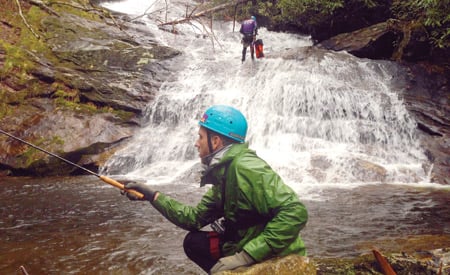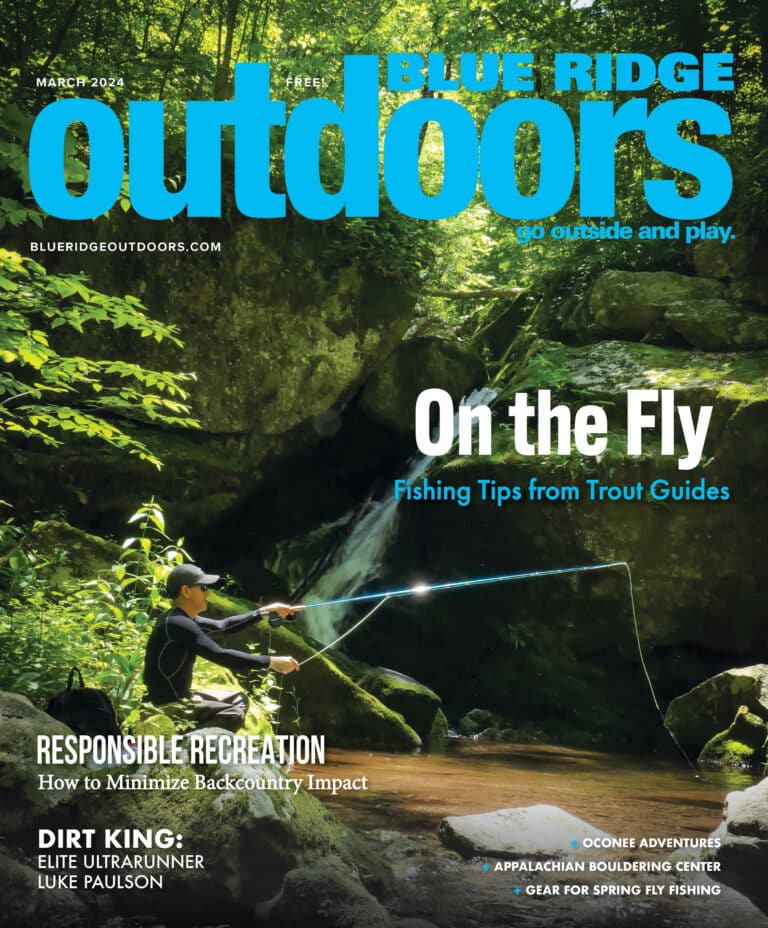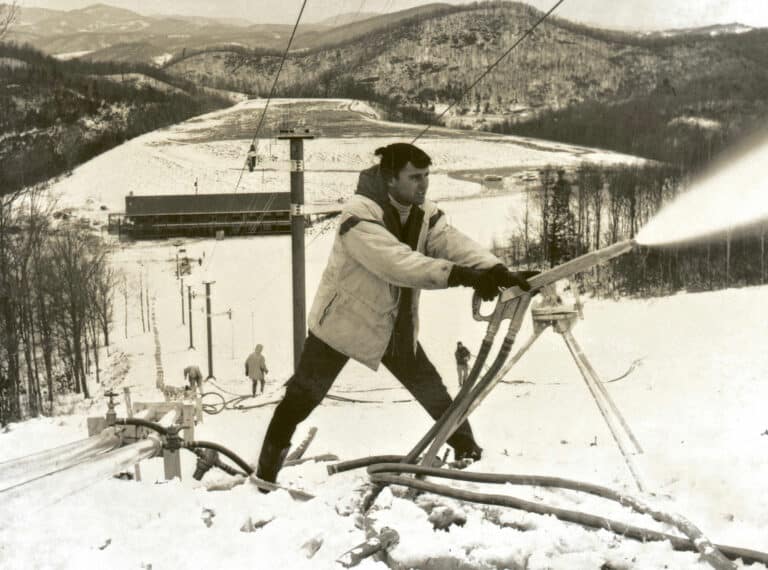Before I even have my harness doubled back around my waist, I’m bitching about some petty problem I’m having with my house—something like not being able to find the right paint color for my kitchen. “Lowe’s said they could match the color but what they came up with is not Robin’s Egg. It’s like Cerulean Blue,” I say.
Joe Moerschbacher, scruffy and kind of weathered with a big Pura Vida sticker slapped to the front of his helmet, looks my harness over and says, “Well, the good news is you won’t worry about that at all when you’re hypothermic later today.”
We’re in the Graveyard Fields parking lot, off the Blue Ridge Parkway, gearing up to fish a remote section of Yellowstone Prong. Okay, “fishing” is a bit of an understatement. We’re carrying ultra light tenkara fly rods—a traditional Japanese style of fly rod that telescopes into itself and has no reel, just a fixed line—and wearing full canyoneering gear. The only way to access some of the pools we want to fish is by rappelling waterfalls. It’s the first time I’ve ever had to wear a helmet and a harness to fish.
My buddy Dusty and I have been dreaming about this trip for the better part of a year. We’ve both been mildly obsessed with tenkara since Tenkara USA started infiltrating East Coast fly shops a few years ago. Imagine Western style fly fishing, but strip away all of the hassle and most of the expense. That’s tenkara. Your gear is reduced to just a rod and line (goodbye reel, goodbye fancy vest with a thousand pockets filled with widgets), and some purists, like Tenkara USA founder Daniel Galhardo, only use one fly pattern. Focusing on just one fly eliminates a lot of the learning curve associated with Western trout fishing. You no longer have to be an entomologist with intimate knowledge of local hatch patterns. The cast is even stripped down—forget that big, dramatic casting motion from A River Runs Through It. Tenkara requires just a curt wave of the wrist.
It is single speed mountain biking. Free solo rock climbing. Running barefoot. Swimming naked in a lake. Tenkara is simplicity.
And thanks to the streamlined gear and telescoping rods, tenkara also pairs well with other adventures. You can throw your tiny tenkara rod in your backpack and never notice the weight on mountain bike trips and backpacking excursions. Or canyoneering adventures.
There’s a video that Galhardo made of one of his trips to Japan that shows anglers swimming through pools, hopping from boulder to boulder and climbing waterfalls with full climbing gear. The tight river gorges in the video look exactly like the streams we have here in the Southern Appalachians. The style of canyoneering (they call it “shower climbing”) looks exactly like the kind of canyoneering trips I’d done with Joe Moerschbacher and Pura Vida Adventures. Dusty and I watched the Japanese video and had a light bulb moment.
Why not do a canyoneering/tenkara trip here in Pisgah National Forest?
When Moerschbacher heard what we were planning, he offered to guide us through a couple of canyons he wants to start running trips on. When Galhardo heard what we were planning, he asked to tag along. Turns out, he’d been looking for rivers in the U.S. where he could have the same shower climbing/tenkara experience he had in Japan.
Four months later, there are five of us gearing up for what might be the first canyoneering/tenkara trip in the U.S.—Galhardo, Dusty and myself, Moerschbacher and his canyoneering partner Clay. I like to think of our group as a bit like The A Team, where everybody has his own area of expertise. Moerschbacher and Clay have the canyoneering chops and designed the trip logistics. Galhardo is the trip fishing guru, and Dusty and I have flasks of whiskey.
Tombstone Blues Canyon
From the parking lot, we hike past families in flip-flops who look at us in our wetsuits and gear like we’re aliens. We ditch the trail quickly and get ankle deep in the Yellowstone Prong just before the gorge gets really steep. Moerschbacher has dubbed the walled out, inaccessible portion of the river “Tombstone Blues Canyon.” I like it. It’s foreboding.
We start with a small rappel on the side of a cascade that drops us to a ledge in the middle of the two-tiered waterfall. One by one, we lean into the second rappel, a big vertical drop over the 75-foot falls. The ropes and gear are wet, so the rappel is slow and methodical, giving me a chance to look over my shoulder and take in the site below. At the base of the falls, the river is like a hollowed out bowl of gray rock, thick with lime green moss. On either side of the water are walls of rhododendron that climb almost vertically to the horizon. Galhardo already has his rod out and is fishing a pool hemmed by cartoonishly big boulders before my feet touch the ground.
The water is emerald green because of all of the moss. After the two rappels, it’s full-contact boulder hopping interspersed with short bursts of fishing. I don’t even notice the rain once we get moving, and the wetsuits do a good job of tempering the cold water as we have to wade certain pools between boulder hops.
Galhardo is in the lead, moving swiftly from one boulder to the next, then extending his tenkara rod and setting up his line in a matter of seconds to fish small, clear pools. He casts a handful of times, then moves on to the next patch of boulders and the next pool downstream.
“With small pools like this, I won’t cast more than five times, then I move on,” he tells me when we take a whiskey break.
It’s a schizophrenic, almost ADHD style of fishing that I’ve been looking for my whole life. I don’t have the attention span for the traditional approach to fly fishing, where you can spend half an hour fishing a single pool, walk 10 feet, then spend a half an hour fishing another pool. It’s slow, patient work.
As far as fly fishing gurus go, Galhardo is pretty young, just over 30. He’s from Brazil, and grew up surfing but fell in love with fishing as a teenager before moving to the U.S. when he was 17 to finish high school. He still surfs, goes on extensive rock climbing trips, fishes a ridiculous amount according to his Facebook feed and geeks out on foraging for mushrooms. Patagonia recently introduced a tenkara rod, partnering with TFO — but Galhardo is the man who introduced the style of fishing to the United States, working with Japanese tenkara masters to design and build a line of rods.
He loves blending tenkara with other sports and was originally attracted to the style of fly fishing because of its portability and backpacking potential. Whenever he travels to Japan, he makes time for a “shower climbing” trip.
“I love this kind of stream,” Galhardo says. “There’s no other way to fish this stream except to be inside the canyon. This is exactly what I’ve been looking for.”
Moerschbacher smiles. “If you like this canyon, you’re going to love what we have planned for tomorrow.”
Turn Left At The Grow Field
After we cross the border into Shining Rock Wilderness, Clay tells us about how he and Moerschbacher were bushwhacking to one of the lesser known creeks in the area and found an old, abandoned marijuana grow field deep in the backcountry. Legend has it, there’s also a train still tucked into these woods somewhere, left on an old track after the loggers split and the timber companies sold the land to the federal government.
Day two has us descending and fishing Grassy Canyon, a skinny blue line on the Pisgah Ranger District map that looks like it jumps off the topo contour lines on its way to meet the East Fork Pigeon River. Before bushwhacking to the top of the canyon, Galhardo gives Moerschbacher some quick tenkara lessons on the bigger water of the East Fork.
Moerschbacher says he doesn’t have the patience for fishing. Standing around waiting for a fish to bite isn’t his style. He’s a former professional adventure racer turned full time adventure guide, who spends most of his days leading clients deep into Pisgah’s rugged corners for mountain biking, canyoneering and backpacking trips. He’s 33, carries around the book, Everything I Know About Business, I Learned from the Grateful Dead, and is fond of PBR Tallboys.
Galhardo shows Moerschbacher a simple casting motion, then guides him on how to place the fly on the eddy line, where the calm water meets the fast water. That’s where a fish’s food is. Not 10 minutes later, Moerschbacher pulls in his first fish, a small brook trout with pink and yellow spots. It’s almost as big as the smile on Moerschbacher’s face.
The first step into Grassy Canyon is a 120-foot waterfall that bends like an “S.” It’s a mandatory, two-tier rappel from top to bottom. The second leg of the rappel puts you in the thick of the waterfall before dumping you into a mandatory swim. Grassy is far more technical than Tombstone Blues Canyon, with a number of rappels, mandatory swims, and some fun (read: sketchy) canyoneering-specific moves. There are at least two natural water slides, a couple of boulder jumps, and exactly one death-defying “sling swing.”
This happens at the top of a waterfall that slopes gently at first, before dropping 15 vertical feet into the rocks below. There’s no way to anchor a proper rappel, so Moerschbacher wedges a sling beneath a boulder and extends about six feet of leash. What we have to do is scurry down the edge of the waterfall, grab the leash, then let the water take our bodies around the boulder where we can land on a ledge on the edge of the waterfall before it drops over the edge. If something goes wrong, you’d probably only fall 10 feet or so before you hit something hard. It’s not exactly certain death. More like, “certain manglement.” Or at the very least, “certain sprained ankle.” But there’s no way of knowing any of this because from the top of the falls, we can’t see below the boulder. You have to make a leap of faith, letting the current take you while hoping you can hang onto the leash. It’s easily the coolest thing I’ve done all year.
Between harrowing acrobatic feats, we fish surprisingly large pools and I stop keeping count of the number of fish Galhardo catches. It’s a more physically demanding experience than yesterday’s canyon, but it’s far more rewarding. We’re so high up in this remote, boulder-choked gorge, that I doubt many people have ever fished these pools before.
This is exactly the experience that Galhardo was looking for, saying the river gorges offer the same type of shower climbing he’s found in Japan.
“Canyoneering and tenkara is an interesting mix,” Galhardo says. “Canyoneering is about focus. Like rock climbing, it’s about problem solving. Where’s your next move? The next rock? You get into a zone and your world shrinks to a three-foot radius—your current move and your next move. The rest of the world disappears. Fishing is the exact opposite. With fishing, you have to be hyper aware of everything around you. The brush behind you, the trees above you, the water below you…A fisherman needs to know how he fits into all of that.”
We stop in the middle of the river, standing on two large boulders as the water tumbles away behind us. We’ve been moving through the cold water so quickly, sliding and jumping and swimming, that I haven’t bothered to take it all in. Galhardo pulls out his rod and points upstream. From our boulders, we can see how the last three cascades we’ve rappelled and slid down come together to form a solid 200-foot high wall of water.
“When you blend fishing with canyoneering,” Galhardo adds, “you’re forced to stop and take in your surroundings, which are absolutely stunning.”








